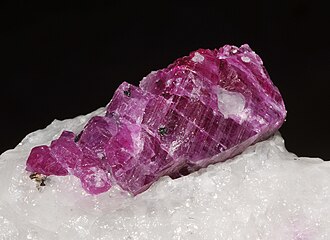The ruby, a vibrant red gemstone, is the birthstone for July. This precious stone has captivated people for thousands of years with its bold color and durability. Let’s look into the world of rubies, from their ancient history to how they’re formed and valued today.
Rubies have been prized since ancient times. The name “ruby” comes from the Latin word “ruber,” which means red. Ancient cultures believed rubies had special powers. Some thought they brought good luck or protected the wearer from harm. Others believed rubies could predict danger by changing color (LOL).
In many parts of the world, rubies were seen as symbols of power and wealth. Kings and queens often wore rubies in their crowns and jewelry. The ancient Hindus called rubies the “king of precious stones.” They believed that offering rubies to the god Krishna would lead to rebirth as an emperor.
The name “ruby” comes from the Latin word “ruber,” which means red.
Rubies are a variety of the mineral corundum. They get their red color from small amounts of chromium in the stone. The Earth creates rubies deep underground over millions of years. They form when the right minerals are exposed to high heat and pressure, similar to the process of diamonds.
Most rubies form in metamorphic rocks, which are changed by heat and pressure over time. Some also form in igneous rocks, which come from cooled magma or lava. Rubies, like other gemstones, often have small imperfections called “inclusions.” These can be other minerals, tiny cracks, or even hollow areas inside them.
Got a question? Are you in the process of creating a custom ruby ring, but aren’t sure which direction to go? Come talk to us for a no-strings chat in our store. We’ll give you all the info you need and guide you in the process, so you can make an educated decision. Just book your meeting here by choosing the best date and time for you, and we’ll see you then.

Rubies have been found in many places around the world. Some of the most famous ruby sources include:
Like other gemstones, rubies are graded using the “Four Cs”: Color, Cut, Clarity, and Carat weight.
Color: The most important factor for rubies. The best rubies have a deep, vivid red color. Some rubies have a slight purplish or pinkish tint.
Cut: A good cut maximizes the ruby’s color and sparkle. Rubies can be cut into various shapes, like oval, round, or cushion.
Clarity: Most rubies have some inclusions. Completely clear rubies are very rare and super-expensive. Some inclusions even increase a ruby’s value if they create interesting patterns.
Carat: This measures the ruby’s weight. Larger rubies are generally more valuable, but other factors like color and clarity are usually more important.
If you’re looking to buy a ruby, here are some tips:
Rubies are quite hard and durable, ranking 9 out of 10 on the Mohs scale of mineral hardness. This makes them suitable for everyday wear. However, they still require some care:
Today, rubies remain popular in jewelry and are still considered one of the most valuable gemstones. They’re often used in engagement rings, as well as other types of jewelry like necklaces, earrings, and bracelets.
Advances in gemology have led to better understanding and identification of rubies. Scientists can now determine where a ruby came from based on its chemical composition and inclusions (technology!). This helps track the gem’s origin and ensure it wasn’t mined in conflict areas.
Synthetic rubies, created in laboratories, are also now common. These have the same chemical and physical properties as natural rubies but are much less expensive. They’re often used in industrial applications, like lasers and watch movements, as well as in affordable jewelry.
Whether you’re born in July or simply admire their fiery red color, rubies continue to be part of beautiful custom jewelry and engagement rings. From ancient myths to modern science, these gemstones have a rich story that’s still being written today.
The ruby symbolizes love, passion, and energy, making it a meaningful choice for those born in July. It is often associated with vitality and protection.
Rubies are known for their vibrant red color, which can range from pinkish to deep crimson. They are also one of the hardest gemstones, rated 9 on the Mohs scale, making them durable for everyday wear.
To maintain the beauty of ruby jewelry, clean it with mild soap and water, and avoid exposure to harsh chemicals. Regular inspections by a jeweler can help ensure settings remain secure.
First of all, it’s your ring, you can do whatever you want. But yes, rubies are popular in engagement rings due to their striking color and symbolism of love. They can be set in various styles, often accompanied by diamonds or other gemstones.
Throughout history, rubies have been believed to possess protective qualities, bringing good fortune and health to their wearers. They have been revered in various cultures as symbols of power and wealth.
Do you have a vision for your custom engagement ring, but aren’t sure how to make it a reality? Allow us to guide you through the process of how to create truly exceptional rings. Schedule your design appointment today and see how Finer Custom Engagement Rings and Diamonds will bring your vision of an engagement ring to life.
© Copyright Finer Custom Jewelry 2024